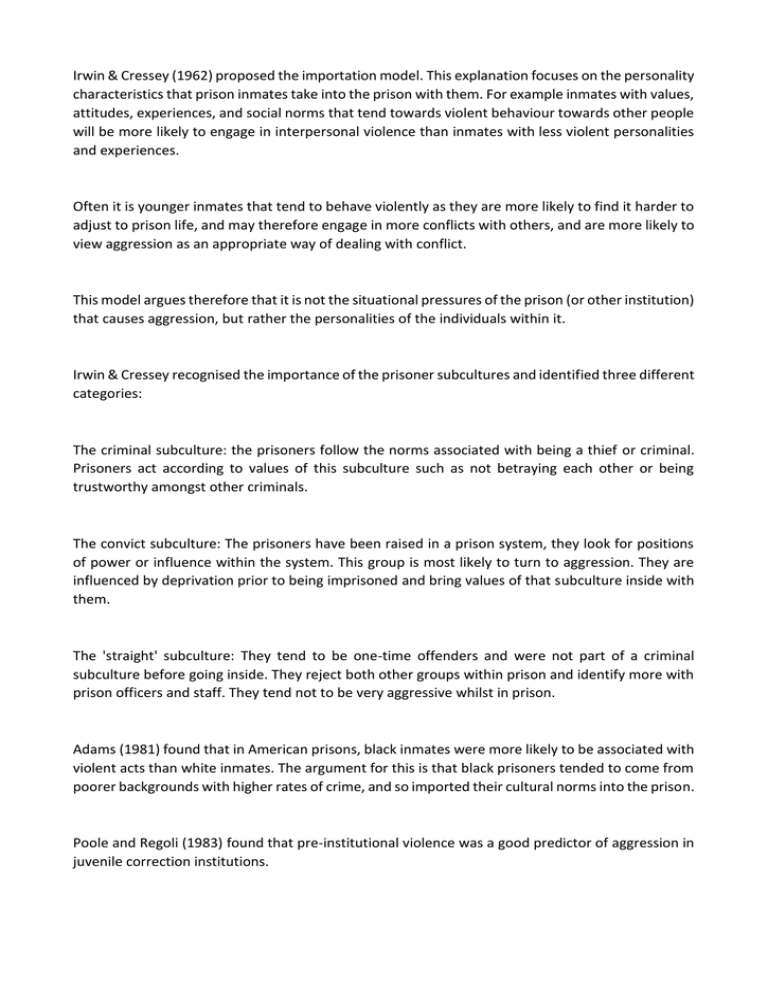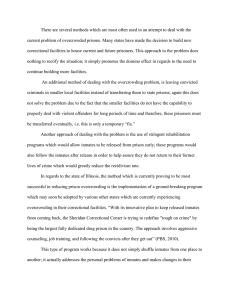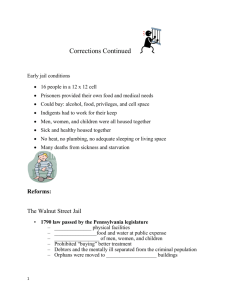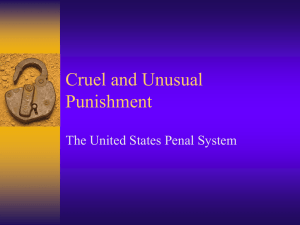Institutional aggression essay
advertisement

Irwin & Cressey (1962) proposed the importation model. This explanation focuses on the personality characteristics that prison inmates take into the prison with them. For example inmates with values, attitudes, experiences, and social norms that tend towards violent behaviour towards other people will be more likely to engage in interpersonal violence than inmates with less violent personalities and experiences. Often it is younger inmates that tend to behave violently as they are more likely to find it harder to adjust to prison life, and may therefore engage in more conflicts with others, and are more likely to view aggression as an appropriate way of dealing with conflict. This model argues therefore that it is not the situational pressures of the prison (or other institution) that causes aggression, but rather the personalities of the individuals within it. Irwin & Cressey recognised the importance of the prisoner subcultures and identified three different categories: The criminal subculture: the prisoners follow the norms associated with being a thief or criminal. Prisoners act according to values of this subculture such as not betraying each other or being trustworthy amongst other criminals. The convict subculture: The prisoners have been raised in a prison system, they look for positions of power or influence within the system. This group is most likely to turn to aggression. They are influenced by deprivation prior to being imprisoned and bring values of that subculture inside with them. The 'straight' subculture: They tend to be one-time offenders and were not part of a criminal subculture before going inside. They reject both other groups within prison and identify more with prison officers and staff. They tend not to be very aggressive whilst in prison. Adams (1981) found that in American prisons, black inmates were more likely to be associated with violent acts than white inmates. The argument for this is that black prisoners tended to come from poorer backgrounds with higher rates of crime, and so imported their cultural norms into the prison. Poole and Regoli (1983) found that pre-institutional violence was a good predictor of aggression in juvenile correction institutions. Keller and Wang (2005) found that prison violence is more likely to occur in facilities with highersecurity (and therefore who had committed more violent crimes) inmates, than those with lower security inmates, again supporting the idea that the inmates had brought violent behaviour into the institution with them. This model does not take into account situational factors such as the fact that the inmates might be frustrated by the lack of freedom, choice and family relationships. This model does not take into account factors like racism which could act as a trigger for violent behaviour. Furthermore aggressive behaviour in prisons could be due to the fact that the inmates feel unsafe, showing aggression could be a strategy to ward off other prisoners therefore an attempt on their part to feel secure. This model does not take into account the influence of mental health problems and addiction to drugs and alcohol. MIND, charity for people with mental disorders, found that over 70% of the prison population has mental health problem or addiction problems, this in itself could be the cause of violent behaviour in the institutions. This is supported by the fact that in the UK the rate of suicide in the population is fourteen times higher than in the rest of the population. Unlike the importation model, the deprivation model argues that it is the situation inmates find themselves in within the prison that causes violent behaviour. This suggests that members of institutions, such as inmates within a prison, are deprived of things such as freedom, home comforts, and social networks, and that this deprivation causes frustration that in turn leads to violent behaviour towards other inmates, the building itself, and staff. The model is an extension of the frustration-aggression hypothesis. Harer and Steffensmeier (1996) suggest that inmates behave in a way that is caused by the difficulties they have adjusting to the ‘pains of imprisonment’. The ‘pains of imprisonment’ include loss of freedom, loss of heterosexual relationships, and isolation from the community, boredom, discomfort and loneliness. An example of this is that when prisons are overcrowded, there is a greater loss of comfort and personal space, which in turn leads to higher levels of interpersonal violence. McCorkle et al (1995) sampled 371 US prisons and found that stress among inmates, such as feelings of loneliness and isolation, are relatively constant among inmates in all prisons, whereas serious outbreaks of violence such as riots are actually relatively isolated. They argue that the way a prison is managed is a greater predictor of serious violence than overcrowding and stress among inmates. Situational factors can be applied to the Abu Ghraib jail where Iraqi prisoners were tortured, ridiculed and dehumanised by American soldiers. These soldiers had not had any training for their role and the instructions given by their superior seem to have been vague and contradictory. The importance of the situational factors was recognised by the judge in this case and some high ranking people lost their job as a result. This model does not account for the influence of social identity for example in Zimbardo’s Stanford prison experiment the results could be better explained as a in-group out-group (them and us) situation where the guards identified to their group and saw the prisoners as the out-group and acted accordingly. These models do not take into account deindividuation. In large institutions such as prison there are large number of people, both the prisoners and the guards wear uniforms so are difficult to identify this leads to a loss of inhibition and personal responsibility which in turn make it more likely that aggression will be expressed. This is the case in normal prison but it was very obvious in Abu Ghraib where the prisoners had bags placed over their heads. However, deindividuation is more likely to be a facilitating factor rather than the cause of aggression. When exposed in the media, a dispositional explanation is commonly offered but this is often a case of scapegoating and does not lead to change whereas a more in depth analysis taking into account the problems of the institution is more likely to lead to change and prevent further incidents of violence.







